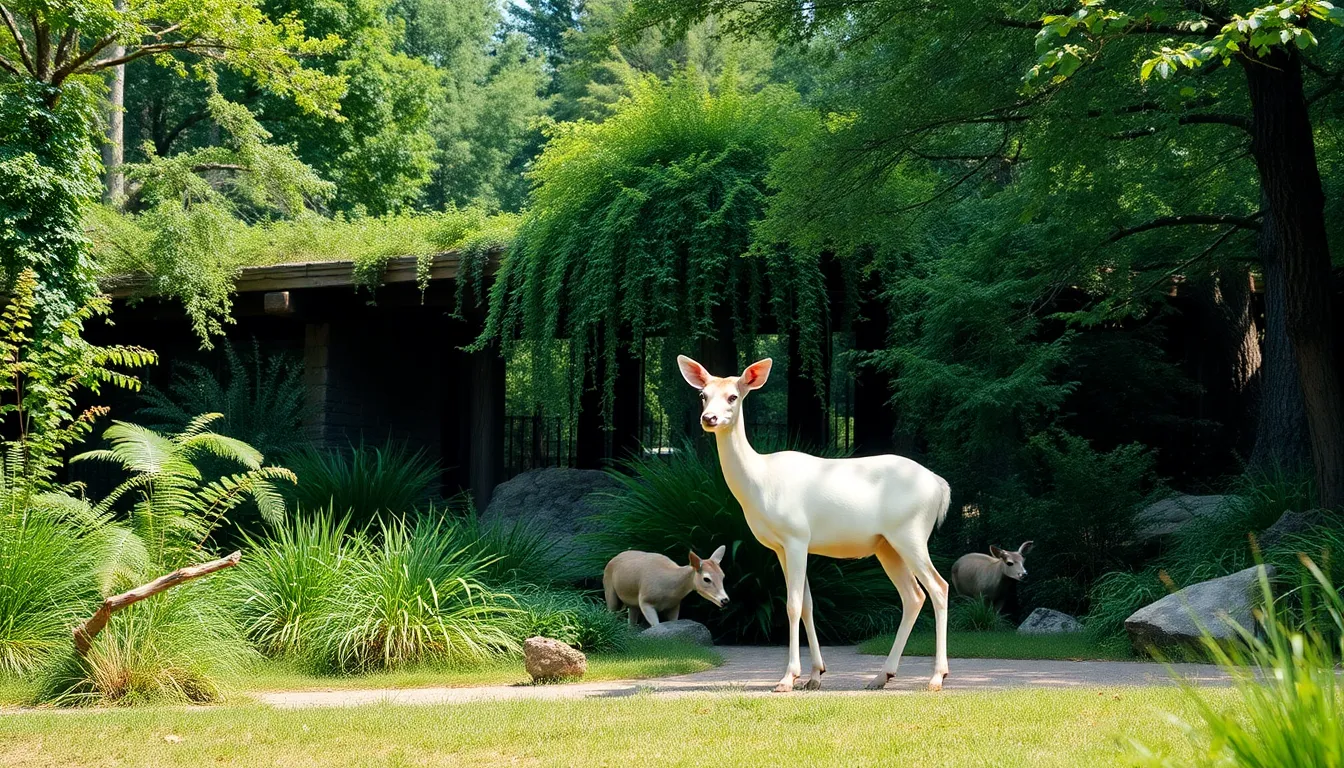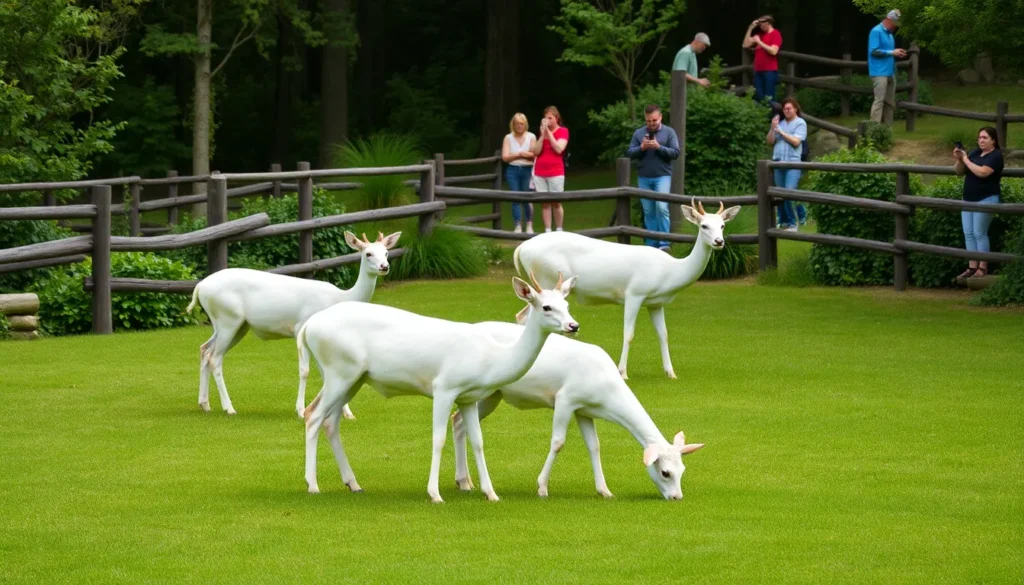Table of Contents
ToggleNestled in the heart of North Carolina, the white deer at the North Carolina Zoo are more than just a rare sight; they’re a majestic reminder of nature’s wonders. With their stunning coats and gentle demeanor, these ethereal creatures draw visitors from near and far, leaving everyone enchanted. Who wouldn’t want to see a deer that looks like it just stepped out of a fairy tale?
Overview of White Deer North Carolina Zoo
The North Carolina Zoo features a unique exhibit dedicated to white deer, showcasing these rare animals in a natural habitat. Visitors can observe the white deer interacting with their surroundings, providing an engaging experience. Known for their striking white coats and gentle demeanor, these deer attract animal lovers and wildlife enthusiasts alike.
Within the zoo, the white deer roam freely in spacious enclosures designed to mimic their natural environment. Observations reveal their peacefulness and social behavior, often seen grazing or resting under trees. Seasonal changes affect their behavior, with increased activity during cooler months and more resting during warmer periods.
Educational programs at the zoo highlight the biology and conservation efforts surrounding white deer. Guides often share insights about their habitat preferences and diet, emphasizing the importance of preserving their natural ecosystems. Guests discover fascinating facts, such as their breeding habits and the significance of genetics in their white color.
Photography opportunities abound, allowing visitors to capture memorable moments with these enchanting creatures. The white deer exhibit serves as a centerpiece of the zoo, drawing in families and individuals seeking a unique wildlife experience. Enthusiasts report that seeing these deer in person creates a sense of wonder and connection to nature.
For those planning a visit, the zoo provides a variety of resources to enhance the experience, including maps and detailed schedules of daily activities. Its commitment to education and conservation aligns with the growing interest in sustainable practices in wildlife habitat management.
History of the Zoo

The North Carolina Zoo, home to the remarkable white deer, boasts a rich history tied to wildlife conservation. Founded in 1974, the zoo began with a vision to create a large-scale, natural habitat experience for both animals and visitors.
Founding and Development
State officials envisioned the zoo as a place emphasizing conservation and education. The site spans over 2,000 acres with diverse ecosystems designed to mimic animals’ natural habitats. In its early years, the zoo aimed to focus on native species and gradually expanded to include exotic animals. By 1990, significant development efforts included the establishment of the white deer exhibit, highlighting the zoo’s commitment to showcasing unique species.
Key Milestones
Noteworthy milestones have marked the zoo’s journey. In 1995, the white deer exhibit opened, attracting visitors eager to observe these enchanting creatures. The expansion into educational programs occurred in 2000, enhancing community engagement through conservation awareness. Annual visitor numbers exceeded 700,000 by 2019, solidifying the zoo’s status as a prominent destination. Recent initiatives include habitat restoration efforts, showcasing a continued commitment to wildlife preservation in the region.
Wildlife and Exhibits
The North Carolina Zoo showcases a diverse range of wildlife, providing visitors with an immersive experience in natural habitats.
Native Species
Native species thrive in the zoo’s expansive settings. Eastern gray squirrels and wild turkeys represent the common wildlife of North Carolina. Visitors might spot these animals interacting with their surroundings as they explore the grounds. The zoo’s commitment to native species education fosters appreciation for local ecosystems. Seasonal changes influence animal behavior, offering unique sightings throughout the year. Engaging educational programs focus on the conservation of these species, enriching the visitor experience.
Unique Features of the Zoo
Unique features abound at the North Carolina Zoo, enhancing its appeal. The large natural habitats allow for close encounters with animals, unlike typical zoos. Hiking trails meander through the exhibits, inviting exploration and discovery. An array of native plant species highlights the relationship between flora and fauna. Special events and interactive programs encourage lifelong learning and appreciation of wildlife. The zoo’s dedication to sustainability reflects in its habitat design and conservation initiatives. Interactive displays provide hands-on learning opportunities, making visits both fun and educational.
Visitor Experience
The North Carolina Zoo offers a magical experience, especially for those eager to see the majestic white deer. Visitors enjoy a well-rounded encounter with nature, education, and conservation.
Ticket Information
Admission costs $15 for adults and $10 for children ages 2 to 12. Seniors aged 62 and older pay $12. Tickets can be purchased online or at the gate. Families often take advantage of family packages, which provide discounts for larger groups. A variety of annual passes are available, enabling frequent visits throughout the year. Additionally, special event tickets may vary in price, so checking the zoo’s website for current rates is advisable.
Amenities and Accessibility
The zoo features several amenities to enhance the visitor experience. Restrooms and nursing areas are conveniently located throughout the grounds. Picnic areas provide space for families to relax and enjoy their meals. Accessible paths ensure everyone can navigate the zoo comfortably, with wheelchairs available for rental. Dining options range from casual cafes to picnic-friendly spots offering local fare. Educational exhibits and interactive displays cater to a diverse audience, ensuring an engaging experience for all guests.
Conservation Efforts
Conservation is a key focus at the North Carolina Zoo, particularly regarding the iconic white deer. This commitment includes a variety of education and habitat restoration initiatives aimed at preserving wildlife.
Education Programs
These education programs emphasize white deer biology and their habitat needs. School groups and families participate in interactive sessions that promote conservation awareness. Workshops help attendees learn best practices for protecting local ecosystems. Memorization of key facts about white deer fosters a deeper appreciation for these unique animals. Exhibits feature informative signage that enhances visitors’ understanding of conservation efforts. All educational content aims to make wildlife preservation an engaging experience for everyone.
Habitat Restoration Projects
Several habitat restoration projects target ecosystems critical to the survival of the white deer and other species. The zoo collaborates with local organizations to restore natural habitats damaged by human activity. Replanting native species and removing invasive plants create a balanced environment. Restoration efforts provide a safe haven for white deer, improving their chances of thriving in the wild. Such initiatives demonstrate the zoo’s dedication to long-term wildlife preservation. Community involvement in these projects fosters a sense of shared responsibility for wildlife conservation.
The white deer at the North Carolina Zoo offer a unique and enchanting experience for visitors. Their striking appearance and gentle demeanor create memorable encounters that leave a lasting impression. The zoo’s commitment to education and conservation not only showcases these majestic creatures but also fosters a greater understanding of wildlife preservation.
With engaging programs and a focus on habitat restoration, the zoo plays a vital role in protecting local ecosystems. Families and wildlife enthusiasts alike can enjoy the beauty of the white deer while participating in meaningful conservation efforts. A visit to this remarkable zoo is sure to inspire a deeper appreciation for nature and its many wonders.







